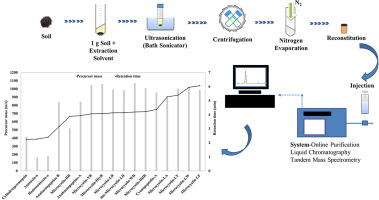Talanta ( IF 5.6 ) Pub Date : 2020-03-12 , DOI: 10.1016/j.talanta.2020.120923 Yanyan Zhang 1 , Joann K Whalen 1 , Sung Vo Duy 2 , Gabriel Munoz 2 , Barry R Husk 3 , Sébastien Sauvé 2

|
Cyanotoxins are associated with harmful cyanobacterial blooms, but also exist in biological soil crusts and soils irrigated with cyanobacteria-contaminated water. To achieve an accurate analysis of cyanotoxins in soil, effective extraction, purification and determination methods are imperative. The most challenging aspect is extracting cyanotoxins from soil, due to their tendency to bind strongly to the soil matrix. We used a methanol-ammonium acetate solution to efficiently extract 17 cyanotoxins (microcystins, cylindrospermopsin, anatoxins, anabaenopeptins, and cyanopeptolin) from soil. The extract was purified by on-line solid-phase extraction coupled with ultra-high-performance liquid chromatography tandem mass spectrometry. The optimized procedure involved two ultrasonication cycles of 15 min with 4 mL of methanol +200 mM ammonium acetate, which recovered 60% to >90% of the added cyanotoxins from five soils with diverse organic matter, pH and texture. The method improved extraction by up to 10 times compared to a methanol/water solution. Linearity, accuracy and precision were validated on matrix-mixed soil with surrogate microcystin and cylindrospermopsin internal standards. Limits of detection were 0.001–0.3 ng g−1, depending on the cyanotoxin. The method was used to analyze cyanotoxins in 25 field-collected soils from Quebec, Canada. Out of the 25 soil samples, 11 soils had at least one cyanotoxin, and up to 8 different cyanotoxins were detected in one soil. The sum of all microcystins congeners was from 0.02 to 31 ng microcystins g−1 soil. We also detected anabaenopeptin, the first reported occurrence of this cyanotoxin in soil.
中文翻译:

在线纯化液相色谱串联质谱法改进了从土壤中提取多类蓝藻毒素和灵敏定量的方法。
氰毒素与有害的蓝藻水华有关,但也存在于生物土壤结皮和被蓝细菌污染的水灌溉的土壤中。为了准确分析土壤中的氰毒素,必须有效的提取,纯化和测定方法。最具挑战性的方面是从土壤中提取氰毒素,因为它们倾向于与土壤基质牢固结合。我们使用甲醇-乙酸铵溶液从土壤中有效提取了17种氰毒素(微囊藻毒素,环精子环蛋白,Anatoxins,anaabapeptins和cyanepteptolin)。萃取物通过在线固相萃取结合超高效液相色谱串联质谱法进行纯化。优化程序包括两个超声循环,每次15分钟,分别用4 mL甲醇+200 mM乙酸铵,从五种具有不同有机质,pH和质地的土壤中回收了60%至> 90%的添加的氰毒素。与甲醇/水溶液相比,该方法可将提取效率提高多达10倍。线性,准确性和精密度在替代微囊藻毒素和圆柱精子内标物内标物上进行了验证。检出限为0.001–0.3 ng g-1,取决于氰毒素。该方法用于分析加拿大魁北克省25种田间采集的土壤中的氰毒素。在25个土壤样本中,有11种土壤至少含有一种氰毒素,并且在一种土壤中检测到多达8种不同的氰毒素。所有微囊藻毒素同源物的总和为0.02至31 ng微囊藻毒素g -1土壤。我们还检测到Anabaenopeptin,这是该氰毒素在土壤中的首次报道。











































 京公网安备 11010802027423号
京公网安备 11010802027423号